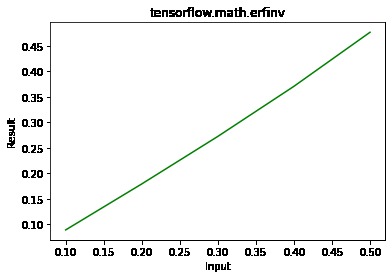TensorFlow是Google设计的开源Python库,用于开发机器学习模型和深度学习神经网络。
erfinv()用于计算元素明智的逆误差函数。
用法:tensorflow.math.erfinv( x, name)
参数:
- x:它是输入张量。允许的dtypes是bfloat16,half,float32,float64。
- name(optional):它定义了操作的名称。
返回值:它返回与x相同dtype的张量。
范例1:
Python3
# importing the library
import tensorflow as tf
# Initializing the input tensor
a = tf.constant([.1, .2, .3, .4, .5], dtype = tf.float64)
# Printing the input tensor
print('Input:', a)
# Calculating inverse error
res = tf.math.erfinv(x = a)
# Printing the result
print('Result:', res)输出:
Input: tf.Tensor([0.1 0.2 0.3 0.4 0.5], shape=(5, ), dtype=float64) Result: tf.Tensor([0.08885599 0.17914345 0.27246271 0.37080716 0.47693628], shape=(5, ), dtype=float64)
范例2:可视化
Python3
# importing the library
import tensorflow as tf
import matplotlib.pyplot as plt
# Initializing the input tensor
a = tf.constant([.1, .2, .3, .4, .5], dtype = tf.float64)
# Calculating inverse error
res = tf.math.erfinv(x = a)
# Plotting the graph
plt.plot(a, res, color ='green')
plt.title('tensorflow.math.erfinv')
plt.xlabel('Input')
plt.ylabel('Result')
plt.show()输出:

相关用法
注:本文由纯净天空筛选整理自aman neekhara大神的英文原创作品 Python – tensorflow.math.erfinv()。非经特殊声明,原始代码版权归原作者所有,本译文未经允许或授权,请勿转载或复制。
